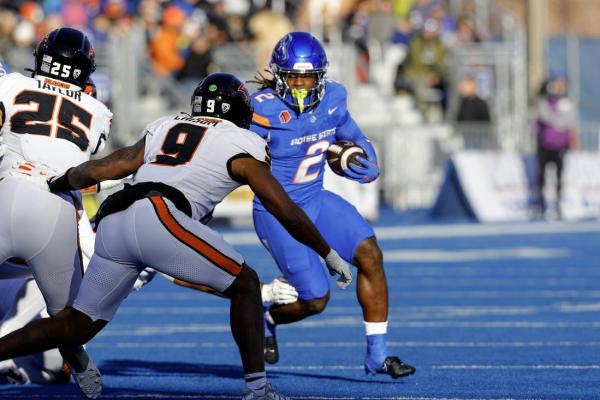After a thrilling conference championship Saturday and a drawn-out reveal show Sunday, the inaugural 12-team College Football Playoff field is set.
The first true tournament in FBS history has plenty to love — and elements to loathe.
What Went Right: Unique opening-round matchups
Whether the first round proves to be more competitive than the four-team Playoff’s often lopsided semifinal matchups remains to be seen. Until then, there is at least intrigue in the historic rarity of the four pairings.
One opening-round matchup — ACC automatic qualifier Clemson at Texas — is a first-time encounter between two programs that combine for seven claimed national championships. Of the other three, the most recent contest occurred in 1996 when Tennessee topped Ohio State in the Citrus Bowl.
The Vols and Buckeyes meet as the No. 9 and No. 8 seeds at Ohio State’s Horseshoe, with the winner advancing to face top overall seed Oregon.
SMU, a perhaps surprising final at-large selection given the Mustangs’ dearth of high-profile wins, meets Penn State for the third time ever and first since 1978. The Nittany Lions scored a 26-21 come-from-behind win in Happy Valley, where they will again host SMU.
The Penn State victory ended a 30-year stalemate after the first and only meeting in the 1948 Cotton Bowl produced a 13-13 tie. Here’s hoping the third part of a 76-year trilogy is as closely contested as the initial two.
Meanwhile, the matchup with the most previous installments is the closest in proximity — less than 200 miles separate in-state counterparts Indiana and Notre Dame — and the most lopsided.
The Fighting Irish and Hoosiers last played in 1991, with Notre Dame’s 49-27 win marking its sixth straight victory by multiple scores. Indiana’s last win in the series came in 1950, a 20-7 Hoosiers victory in Bloomington.
What Went Right: Boise State’s big opportunity
Although not the first outsider to reach or win a Bowl Championship Series game, Boise State’s 2007 Fiesta Bowl victory over Oklahoma was arguably the most pivotal moment in building support for outsiders to compete for the national championship.
The Broncos spent two decades knocking on the door, beginning with their perfect 2004 regular season, extending through two Fiesta Bowl wins, and withstanding the heartbreak of late-season losses in 2010 and 2011.
The celebration in response to Boise State being part of the bracket — and not just in, but as the No. 3 seed with a bye into the quarterfinals — marked a culmination of generations of effort for just this opportunity.
What Went Right: âFootball weather’ comes to the postseason
From the birth of the bowl system with the first-ever Rose Bowl Game, college football’s postseason has resided primarily in warm-weather destinations. This makes sense for the original purpose of bowl games as showcases and celebrations of a team’s regular-season performance, but less so for the goal of crowning a national champion.
After decades of playing what often amounted to road games in the postseason, northern teams get their opportunity to host. Three of the four first-round contests are in such climates — though Indiana won’t be particularly disadvantaged by weather when playing Notre Dame in South Bend.
With average December highs in Pennsylvania in the 30s, SMU will need its heaters on the sideline at Penn State’s Beaver Stadium. The more intriguing trip, however, is Tennessee’s to Ohio State.
Longtime college football fans know the arguments about SEC teams playing in Big Ten country late in the year. Pitting two high-quality teams from the two leagues head-to-head in such conditions is a highlight of this new postseason system.
And, given Tennessee and Ohio State have two of the nation’s best defenses, expect a style of play befitting what is often described as football weather.
What Went Wrong: More teams means more politicking
When Mack Brown seemingly spent as much time on TV campaigning in 2004 as that year’s presidential candidates, George W. Bush and John Kerry, his Texas Longhorns were among a small collection of teams vying for BCS bids.
With the 12-team Playoff opening the top postseason opportunities to as many as 20 teams realistically, the political campaign ads that mercilessly ended in early November were replaced by the politicking of college football figures.
Iowa State athletic director Jamie Pollard spent last week taking shots at SMU and other programs over strength of schedule — a point neglecting that the Cyclones’ losses came to unranked Texas Tech and sub-.500 Kansas. Arizona State’s thorough dismantling of Iowa State in the Big 12 Championship Game solved that debate at the proverbial ballot box.
However, brace yourself for an offseason of recount demands coming out of the SEC.
Alabama’s exclusion at 9-3, while 11-2 SMU landed the final at-large spot, is sure to play into the same controversy that South Carolina coach Shane Beamer leaned into last week.
Beamer told The State (Columbia, S.C.) last week that his program may consider changing its nonconference scheduling in response to its seemingly inevitable Playoff snub. It’s an odd position, given South Carolina’s three losses all came in-conference, and the Gamecocks’ nonleague slate included sub-.500 teams Old Dominion, Akron and FCS Wofford.
But then again, how often are political campaign pitches rooted in logic?
What Went Wrong: Quantity over quality?
A more salient position in Beamer’s case for South Carolina is that the Gamecocks scored quality wins during a season-ending, six-game streak. With its Rivalry Week defeat of Clemson, South Carolina added a victory over a Playoff qualifier to complement victories over Texas A&M and Missouri.
Alabama, meanwhile, boasts wins over No. 2 overall seed Georgia and that same South Carolina team in contention.
SMU’s resume might be the most likely to draw ire, given the Mustangs received the last at-large berth. However, SMU beat nine- and eight-win Duke and Louisville, with two losses by a combined six points.
Indiana should be the more contentious at-large choice, with the Hoosiers beating only one team that finished above .500: 7-5 Michigan. Indiana’s only other matchup with an above-.500 opponent was a 38-15 blowout at Ohio State.
That’s something Alabama and South Carolina have in common with Indiana, as all three teams lost in routs. Alabama dropped a 24-3 decision late in the season at Oklahoma that presumably doomed the Crimson Tide’s chances, while South Carolina lost to Ole Miss 27-3.
To that end, there are arguments to be made for and against every team that was on the bubble. No system will ever appease all parties.
What Went Wrong: Seeding conundrum
Much of the Playoff’s very existence flies in the face of college football tradition. One facet of how the field was set that upholds tradition in its own small way is rewarding teams for winning their conferences by reserving the four first-round byes for league champions.
When this format was implemented, however, the committee could not have envisioned that two of the top five conference champions would not be ranked in the top 10.
Because three-loss Clemson survived a furious SMU comeback in the ACC championship game, and Arizona State caught fire after underwhelming losses to Texas Tech and Cincinnati to win a weak Big 12, the committee was in the unusual position of having to slot a non-power conference champion and double-digit-ranked team in a top-four spot.
This first edition of the Playoff seems likely to be the last to use this format, even if this scenario seems like an outlier.









